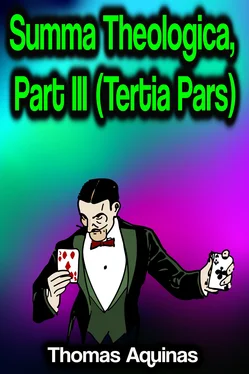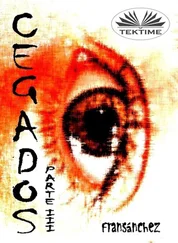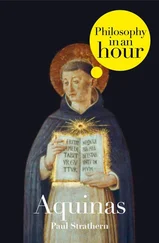Reply Obj. 2: Although Christ's cross was not united to the Word of God in Person, yet it was united to Him in some other way, viz. by representation and contact. And for this sole reason reverence is shown to it.
Reply Obj. 3: By reason of the contact of Christ's limbs we worship not only the cross, but all that belongs to Christ. Wherefore Damascene says (De Fide Orth. iv, 11): "The precious wood, as having been sanctified by the contact of His holy body and blood, should be meetly worshiped; as also His nails, His lance, and His sacred dwelling-places, such as the manger, the cave and so forth." Yet these very things do not represent Christ's image as the cross does, which is called "the Sign of the Son of Man" that "will appear in heaven," as it is written (Matt. 24:30). Wherefore the angel said to the women (Mk. 16:6): "You seek Jesus of Nazareth, Who was crucified": he said not "pierced," but "crucified." For this reason we worship the image of Christ's cross in any material, but not the image of the nails or of any such thing. _______________________
FIFTH ARTICLE [III, Q. 25, Art. 5]
Whether the Mother of God Should Be Worshipped with the Adoration of Latria ?
Objection 1: It would seem that the Mother of God is to be worshiped with the adoration of latria. For it seems that the same honor is due to the king's mother as to the king: whence it is written (3 Kings 2:19) that "a throne was set for the king's mother, and she sat on His right hand." Moreover, Augustine [*Sermon on the Assumption, work of an anonymous author] says: "It is right that the throne of God, the resting-place of the Lord of Heaven, the abode of Christ, should be there where He is Himself." But Christ is worshiped with the adoration of latria. Therefore His Mother also should be.
Obj. 2: Further, Damascene says (De Fide Orth. iv, 16): "The honor of the Mother reflects on the Son." But the Son is worshiped with the adoration of latria. Therefore the Mother also.
Obj. 3: Further, Christ's Mother is more akin to Him than the cross. But the cross is worshiped with the adoration of latria. Therefore also His Mother is to be worshiped with the same adoration.
On the contrary, The Mother of God is a mere creature. Therefore the worship of latria is not due to her.
I answer that, Since latria is due to God alone, it is not due to a creature so far as we venerate a creature for its own sake. For though insensible creatures are not capable of being venerated for their own sake, yet the rational creature is capable of being venerated for its own sake. Consequently the worship of latria is not due to any mere rational creature for its own sake. Since, therefore, the Blessed Virgin is a mere rational creature, the worship of latria is not due to her, but only that of dulia : but in a higher degree than to other creatures, inasmuch as she is the Mother of God. For this reason we say that not any kind of dulia is due to her, but hyperdulia.
Reply Obj. 1: The honor due to the king's mother is not equal to the honor which is due to the king: but is somewhat like it, by reason of a certain excellence on her part. This is what is meant by the authorities quoted.
Reply Obj. 2: The honor given to the Mother reflects on her Son, because the Mother is to be honored for her Son's sake. But not in the same way as honor given to an image reflects on its exemplar: because the image itself, considered as a thing, is not to be venerated in any way at all.
Reply Obj. 3: The cross, considered in itself, is not an object of veneration, as stated above (AA. 4, 5). But the Blessed Virgin is in herself an object of veneration. Hence there is no comparison. _______________________
SIXTH ARTICLE [III, Q. 25, Art. 6]
Whether Any Kind of Worship Is Due to the Relics of the Saints?
Objection 1: It would seem that the relics of the saints are not to be worshiped at all. For we should avoid doing what may be the occasion of error. But to worship the relics of the dead seems to savor of the error of the Gentiles, who gave honor to dead men. Therefore the relics of the saints are not to be honored.
Obj. 2: Further, it seems absurd to venerate what is insensible. But the relics of the saints are insensible. Therefore it is absurd to venerate them.
Obj. 3: Further, a dead body is not of the same species as a living body: consequently it does not seem to be identical with it. Therefore, after a saint's death, it seems that his body should not be worshiped.
On the contrary, It is written (De Eccles. Dogm. xl): "We believe that the bodies of the saints, above all the relics of the blessed martyrs, as being the members of Christ, should be worshiped in all sincerity": and further on: "If anyone holds a contrary opinion, he is not accounted a Christian, but a follower of Eunomius and Vigilantius."
I answer that, As Augustine says (De Civ. Dei i, 13): "If a father's coat or ring, or anything else of that kind, is so much more cherished by his children, as love for one's parents is greater, in no way are the bodies themselves to be despised, which are much more intimately and closely united to us than any garment; for they belong to man's very nature." It is clear from this that he who has a certain affection for anyone, venerates whatever of his is left after his death, not only his body and the parts thereof, but even external things, such as his clothes, and such like. Now it is manifest that we should show honor to the saints of God, as being members of Christ, the children and friends of God, and our intercessors. Wherefore in memory of them we ought to honor any relics of theirs in a fitting manner: principally their bodies, which were temples, and organs of the Holy Ghost dwelling and operating in them, and are destined to be likened to the body of Christ by the glory of the Resurrection. Hence God Himself fittingly honors such relics by working miracles at their presence.
Reply Obj. 1: This was the argument of Vigilantius, whose words are quoted by Jerome in the book he wrote against him (ch. ii) as follows: "We see something like a pagan rite introduced under pretext of religion; they worship with kisses I know not what tiny heap of dust in a mean vase surrounded with precious linen." To him Jerome replies (Ep. ad Ripar. cix): "We do not adore, I will not say the relics of the martyrs, but either the sun or the moon or even the angels"—that is to say, with the worship of latria. "But we honor the martyrs' relics, so that thereby we give honor to Him Whose martyrs [*The original meaning of the word 'martyr,' i.e. the Greek martys is 'a witness'] they are: we honor the servants, that the honor shown to them may reflect on their Master." Consequently, by honoring the martyrs' relics we do not fall into the error of the Gentiles, who gave the worship of latria to dead men.
Reply Obj. 2: We worship that insensible body, not for its own sake, but for the sake of the soul, which was once united thereto, and now enjoys God; and for God's sake, whose ministers the saints were.
Reply Obj. 3: The dead body of a saint is not identical with that which the saint had during life, on account of the difference of form, viz. the soul: but it is the same by identity of matter, which is destined to be reunited to its form.
Question 26. Of Christ As Called The Mediator Of God And Man (In Two Articles)
We have now to consider how Christ is called the Mediator of God and man, and under this head there are two points of inquiry:
(1) Whether it is proper to Christ to be the Mediator of God and man?
(2) Whether this belongs to Him by reason of His human nature? _______________________
FIRST ARTICLE [III, Q. 26, Art. 1]
Читать дальше












